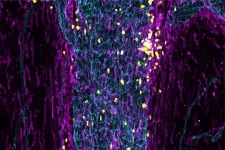INFORMATION:
New findings on devonian 'platypus fish' cast light on evolution of modern jawed vertebrates
2021-01-27
(Press-News.org) New findings on the brain and inner ear cavity of a 400-million-year-old platypus-like fish cast light on the evolution of modern jawed vertebrates, according to a study led by Dr. ZHU Youan and Dr. LU Jing from the Institute of Vertebrate Paleontology and Paleoanthropology (IVPP) of the Chinese Academy of Sciences.
The study was published in Current Biology on Jan 27.
Back in 1960s, Paleontologist Dr. Gavin C. Young found several fossils of a long-beaked fish, a type of placoderm, in the Burrinjuck limestones in Australia. He named the fish Brindabellaspis stensioi, and other people jokingly dubbed it "platypus fish" because of its long beak.
Most excitingly, the fossil of Brindabellaspis included the braincase, a kind of bony box inside the head that housed the brain and sensory organs. The morphology of the brain cavity suggested it was closely related to primitive jawless fishes.
A team of scientists from China, Australia, the UK and Sweden re-investigated these mysterious fossils using cutting-edge MicroCT scanning and digital reconstruction. These techniques use X-rays to look inside and digitally dissect fossils. The fossils can even be 3D printed, without causing any harm to the extremely fragile fossils.
Much to their surprise, the researchers found previously unseen areas inside the braincase that contain a critical pack of information: This ancient placoderm fish has an inner ear that resembles modern jawed vertebrates, including modern sharks and bony fishes, as well as the distant ancestors of humans.
Most placoderms have distinctive inner ear features, with a very large sac known as a vestibule placed in the center, separating all other components. In contrast, the inner ear of the ancestors of modern fishes and land-dwelling vertebrates is compact, with much more connection between different components. This latter condition is exactly what the researchers found inside the skull of Brindabellaspis. In fact, if you put the inner ear of Brindablleaspis and that of a human side to side, the upper part looks very similar, and is totally different from previously known placoderms.
Modern bony fishes and land-dwelling vertebrates have a closed endolymphatic system. Most early fishes, however, as well as modern sharks, have an open endolymphatic system that connects to the water outside. In placoderms, this connection was via a simple tube, whereas sharks have an endolymphatic sac that acts like a reservoir. Once again, the condition in Brindabellaspis is unlike that of other placoderms, with a sac resembling that of sharks.
As a sort of placoderm-bony-fish-shark chimera, Brindabellaspis has a profound impact on our understanding of the early evolutionary history of vertebrates. Scientists had long regarded placoderms as a natural group of their own. However, more recently, researchers began to suspect that placoderms do not form a natural group, and the origins of modern jawed vertebrates lay within the assemblage.
With a mosaic of undeniably primitive features and a surprisingly modern inner ear, Brindabellaspis lends support to two conflicting hypotheses of relationships. Using the parsimony method of analysis, most placoderms form a natural group, but some - including Brindabelllapsis - are found to be more closely related to living jawed fish groups. When Bayesian analysis is used, however, placoderms do not form a natural group, and Brindabellaspis is more removed from living jawed fishes.
Which hypothesis is closer to the truth? Dr. ZHU Youan, the first author of the paper, explained: "The simple answer is we don't know yet. Molecular data suggest that jawed vertebrates arose in the Middle Ordovician, some 60 million years before Brindabellaspis was cruising the ancient reefs. The answer may be in that missing 60-million-year period, in which fossils are very rare."
Scientists are still piecing together this jigsaw puzzle, but one thing is for sure: There is much more critical information contained inside fossils than meets the eye, just waiting for X-rays to reveal it.
ELSE PRESS RELEASES FROM THIS DATE:
How does the immune system keep tabs on the brain?
2021-01-27
Alzheimer's disease, multiple sclerosis, autism, schizophrenia and many other neurological and psychiatric conditions have been linked to inflammation in the brain. There's growing evidence that immune cells and molecules play a key role in normal brain development and function as well. But at the core of the burgeoning field of neuroimmunology lies a mystery: How does the immune system even know what's happening in the brain? Generations of students have been taught that the brain is immunoprivileged, meaning the immune system largely steers clear of it.
Now, researchers at Washington University School of Medicine in St. Louis believe they have figured out how the immune system keeps tabs on what's going on in the brain. Immune ...
A new study reveals an "Achilles heel" of cancer cells
2021-01-27
What makes cancer cells different from ordinary cells in our bodies? Can these differences be used to strike at them and paralyze their activity? This basic question has bothered cancer researchers since the mid-19th century. The search for unique characteristics of cancer cells is a building block of modern cancer research. A new study led by researchers from Tel Aviv University shows, for the first time, how an abnormal number of chromosomes (aneuploidy) -- a unique characteristic of cancer cells that researchers have known about for decades -- could become a weak ...
Key switchgrass genes identified, which could mean better biofuels ahead
2021-01-27
Biologists believe they are one step closer to a long-held goal of making a cheap, widely available plant a source for energy and fuel, meaning one of the next big weapons in the battle against climate change may be able to trace its roots to the side of a Texas highway.
Researchers at The University of Texas at Austin, HudsonAlpha Institute for Biotechnology, the U.S. Department of Energy (DOE) and other institutions have published a complex genome analysis of switchgrass, a promising biofuel crop.
The team tied different genes to better performance in varying climates across North America, which now gives scientists a road map for breeding ...
Antibody highs and lows in survivors of Ebola
2021-01-27
A high proportion of survivors of Ebola experienced a resurgence in antibody levels nearly a year after recovery, a new University of Liverpool study has found.
Published today in Nature, the finding hints that hidden reservoirs of virus could exist long after symptoms ease and has implications for monitoring programmes and vaccine strategies.
When a person is infected with Ebola virus, their body produces antibodies to fight the disease. Antibody concentrations peak and then decline slowly over time, providing the body with some degree of immune protection ...
Scientists discover a new promising target for diabetes treatment
2021-01-27
Researchers have discovered a novel and druggable insulin inhibitory receptor, named inceptor. The latest study from Helmholtz Zentrum Muenchen, the Technical University of Munich and the German Center for Diabetes Research is a significant milestone for diabetes research as the scientific community celebrates 100 years of insulin and 50 years of insulin receptor discovery. The blocking of inceptor function leads to an increased sensitisation of the insulin signaling pathway in pancreatic beta cells. This might allow protection and regeneration of beta cells for diabetes remission.
Diabetes mellitus is a complex disease characterized by the loss or dysfunction of insulin-producing beta cells in the islets of Langerhans, ...
Well connected through amides
2021-01-27
Linking molecular components through amide bonds is one of the most important reactions in research and the chemical industry. In the journal Angewandte Chemie, scientists have now introduced a new type of reaction for making amide bonds. Called an ASHA ligation, this reaction is fast, efficient, works under mild aqueous conditions, and is broadly applicable.
Amide bonds are the bond between a carbonyl carbon (C=O) and an organic nitrogen atom. It is amide bonds that link individual amino acids together into proteins and bind monomers into polyamide plastics like perlon ...
Findings may help close door on COVID-19
2021-01-27
Researchers at Vanderbilt University Medical Center (VUMC) and the University of Texas Medical Branch (UTMB) at Galveston have discovered what may be the Achilles' heel of the coronavirus, a finding that may help close the door on COVID-19 and possibly head off future pandemics.
The coronavirus is an RNA virus that has, in its enzymatic toolkit, a "proofreading" exoribonuclease, called nsp14-ExoN, which can correct errors in the RNA sequence that occur during replication, when copies of the virus are generated.
Using cutting-edge technologies and novel bioinformatics approaches, the researchers discovered that this ExoN also regulates the rate of recombination, the ability of the coronavirus ...
Getting to net zero -- and even net negative -- is surprisingly feasible, and affordable
2021-01-27
Reaching zero net emissions of carbon dioxide from energy and industry by 2050 can be accomplished by rebuilding U.S. energy infrastructure to run primarily on renewable energy, at a net cost of about $1 per person per day, according to new research published by the Department of Energy's Lawrence Berkeley National Laboratory (Berkeley Lab), the University of San Francisco (USF), and the consulting firm Evolved Energy Research.
The researchers created a detailed model of the entire U.S. energy and industrial system to produce the first detailed, peer-reviewed study of how to achieve carbon-neutrality by 2050. According to the Intergovernmental Panel on Climate Change (IPCC), the world must reach zero net CO2 ...
Culture shapes willingness to share personal data to reduce COVID-19 spread
2021-01-27
CHAMPAIGN, Ill. -- Culture, civic-mindedness and privacy concerns influence how willing people are to share personal location information to help stem the transmission of COVID-19 in their communities, a new study finds. Such sharing includes giving public health authorities access to their geographic information via data gathered from phone calls, mobile apps, credit card purchases, wristband trackers or other technologies.
Reported in the International Journal of Geo-Information, the study will help public health officials better tailor their COVID-19 mitigation strategies to specific cultural contexts, the ...
More than just CO2: It's time to tackle short-lived climate-forcing pollutants
2021-01-27
Climate change mitigation is about more than just CO2. So-called "short-lived climate-forcing pollutants" such as soot, methane, and tropospheric ozone all have harmful effects. Climate policy should be guided by a clearer understanding of their differentiated impacts.
It is common practice in climate policy to bundle the climate warming pollutants together and express their total effects in terms of "CO2 equivalence". This 'equivalence' is based on a comparison of climate effects on a 100-year timescale. This approach is problematic, as IASS scientist Kathleen ...







